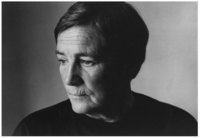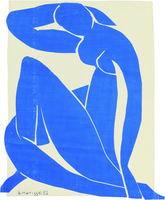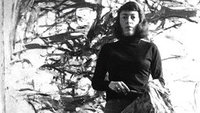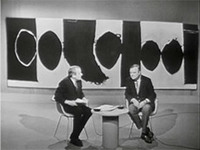Items
Tag
Abstract Expressionism
-
 Agnes Martin Agnes Martin Born on a farm in rural Saskatchewan, Canada, Agnes Martin immigrated to the United States in 1932 in the hopes of becoming a teacher. After earning a degree in art education, she moved to the desert plains of Taos, New Mexico, where she made abstract paintings with organic forms, which attracted the attention of renowned New York gallerist Betty Parsons, who convinced the artist to join her roster and move to New York in 1957. There, Martin lived and worked on Coenties Slip, a street in Lower Manhattan, alongside a community of artists—including Robert Indiana, Ellsworth Kelly, and Jack Youngerman—who were all drawn to the area’s cheap rents, expansive loft spaces and proximity to the East River. Harbor Number 1 (1957), one of Martin’s earliest New York paintings, combines the geometric abstraction of her earlier Taos work with the newfound inspiration of the harbor landscape, evident in her choice of blue-gray palette. Over the course of the next decade, Martin developed her signature format: six by six foot painted canvases, covered from edge to edge with meticulously penciled grids and finished with a thin layer of gesso. Though she often showed with other New York abstractionists, Martin’s focused pursuit charted new terrain that lay outside of both the broad gestural vocabulary of Abstract Expressionism and the systematic repetitions of Minimalism. Rather, her practice was tethered to spirituality and drew from a mix of Zen Buddhist and American Transcendentalist ideas. For Martin, painting was “a world without objects, without interruption… or obstacle. It is to accept the necessity of … going into a field of vision as you would cross an empty beach to look at the ocean.”1 In 1967, at the height of her career, Martin faced the loss of her home to new development, the sudden death of her friend Ad Reinhardt, and the growing strain of mental illness; she left New York, and returned to Taos, where she abandoned painting, instead pursuing writing and meditation in isolation. Her return to painting in 1974 was marked by a subtle shift in style: no longer defined by the delicate graphite grid, compositions such as Untitled Number 5 (1975) display bolder geometric schemes—like distant relatives of her earliest works. In these late paintings, Martin evoked the warm palette of the arid desert landscape where she remained for the rest of her life. Introduction by Jennifer Harris, Curatorial Assistant, Department of Painting and Sculpture, 2016
Agnes Martin Agnes Martin Born on a farm in rural Saskatchewan, Canada, Agnes Martin immigrated to the United States in 1932 in the hopes of becoming a teacher. After earning a degree in art education, she moved to the desert plains of Taos, New Mexico, where she made abstract paintings with organic forms, which attracted the attention of renowned New York gallerist Betty Parsons, who convinced the artist to join her roster and move to New York in 1957. There, Martin lived and worked on Coenties Slip, a street in Lower Manhattan, alongside a community of artists—including Robert Indiana, Ellsworth Kelly, and Jack Youngerman—who were all drawn to the area’s cheap rents, expansive loft spaces and proximity to the East River. Harbor Number 1 (1957), one of Martin’s earliest New York paintings, combines the geometric abstraction of her earlier Taos work with the newfound inspiration of the harbor landscape, evident in her choice of blue-gray palette. Over the course of the next decade, Martin developed her signature format: six by six foot painted canvases, covered from edge to edge with meticulously penciled grids and finished with a thin layer of gesso. Though she often showed with other New York abstractionists, Martin’s focused pursuit charted new terrain that lay outside of both the broad gestural vocabulary of Abstract Expressionism and the systematic repetitions of Minimalism. Rather, her practice was tethered to spirituality and drew from a mix of Zen Buddhist and American Transcendentalist ideas. For Martin, painting was “a world without objects, without interruption… or obstacle. It is to accept the necessity of … going into a field of vision as you would cross an empty beach to look at the ocean.”1 In 1967, at the height of her career, Martin faced the loss of her home to new development, the sudden death of her friend Ad Reinhardt, and the growing strain of mental illness; she left New York, and returned to Taos, where she abandoned painting, instead pursuing writing and meditation in isolation. Her return to painting in 1974 was marked by a subtle shift in style: no longer defined by the delicate graphite grid, compositions such as Untitled Number 5 (1975) display bolder geometric schemes—like distant relatives of her earliest works. In these late paintings, Martin evoked the warm palette of the arid desert landscape where she remained for the rest of her life. Introduction by Jennifer Harris, Curatorial Assistant, Department of Painting and Sculpture, 2016 -
 Blue Nude II Matisse worked on a series of three blue female nudes. All three are cutouts of a stark blue in the shape of a seated female.
Blue Nude II Matisse worked on a series of three blue female nudes. All three are cutouts of a stark blue in the shape of a seated female. -
 Joan Mitchell: Portrait of an Abstract Painter A powerful and intimate portrait, JOAN MITCHELL: PORTRAIT OF AN ABSTRACT PAINTER captures Mitchell's independent spirit and testifies eloquently to Mitchell's art. Joan Mitchell was born in Chicago in 1926 and died in Paris in 1992. After graduating from the School of the Art Institute of Chicago, Joan settled in New York City in 1950. She was an active participant of New York's dynamic Abstract Expressionist scene and hung out with fellow painters Franz Kline, Willem de Kooning and Philip Guston and, soon, poets Frank O'Hara, James Schuyler and John Ashbery. In the mid-fifties, she moved to Paris, France. There she was part of a circle of friends that included Pierre Matisse, Samuel Beckett and Alberto Giacometti. Mitchell is one of the great abstract painters of the 20th century.
Joan Mitchell: Portrait of an Abstract Painter A powerful and intimate portrait, JOAN MITCHELL: PORTRAIT OF AN ABSTRACT PAINTER captures Mitchell's independent spirit and testifies eloquently to Mitchell's art. Joan Mitchell was born in Chicago in 1926 and died in Paris in 1992. After graduating from the School of the Art Institute of Chicago, Joan settled in New York City in 1950. She was an active participant of New York's dynamic Abstract Expressionist scene and hung out with fellow painters Franz Kline, Willem de Kooning and Philip Guston and, soon, poets Frank O'Hara, James Schuyler and John Ashbery. In the mid-fifties, she moved to Paris, France. There she was part of a circle of friends that included Pierre Matisse, Samuel Beckett and Alberto Giacometti. Mitchell is one of the great abstract painters of the 20th century. -
 On the ethical character of art Motherwell discusses the ethical character of art in this segment of the 1964 public television program ART: New York.
On the ethical character of art Motherwell discusses the ethical character of art in this segment of the 1964 public television program ART: New York.